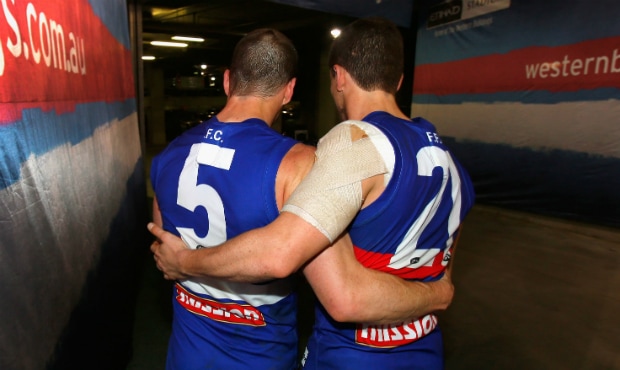| Key stat | League rank | |
| Centre clearance winning % | 46.4% | 2nd |
| Opposition kicks inside 50 marked | 17.6% | Equal 2nd |
| One-on-one contest losing % | 25.8% | 2nd |
SUMMARY Spearheaded by Patrick Dangerfield, the Crows' midfield is elite – there's no question. Rory Sloane took his game to another level and won his first best and fairest and Scott Thompson was still a real force. The side has so many players capable of rotating through the middle that they're going to be hard to stop even when their stars have a rest. If Sam Jacobs can return to his best form, Adelaide's engine room will be right up there with the best in the business again in 2014. – Harry Thring
Brisbane Lions
| Key stat | League rank | |
| Tackling differential | +5.5 | 3rd |
| Kicking efficiency | 65.6% | 6th |
| One-on-one contest losing % | 25.8% | 2nd |
SUMMARY While it's nice being near the top of any statistical category, the fact the Lions are third in tackle differential and sixth in spoils might not be the best sign. In Jack Redden (6.7/game) and Dayne Zorko (5.3) they have two of the most hungry and prolific tacklers in the AFL, but that also comes as a result of not winning the ball. The Lions' poor clearance rate (15th) and contested possession differential (16th) gives them more chances to tackle. The one big positive for the Lions is finishing sixth in kicking efficiency. Often a trouble area over recent years, the blossoming Pearce Hanley, lethal Daniel Rich, classy Sam Mayes and under-rated defender Mitch Golby, gives them plenty of weapons by foot. – Michael Whiting
Carlton
| Key stat | League rank | |
| Contested possession differential | +8.2 | 3rd |
| Score per inside 50 | 51.9% | 5th |
| Contested marks per game | 13.1 | 1st |
SUMMARY These positive returns from 2013 can largely be attributed to the game style demanded by Mick Malthouse, who will accept no compromise on hardness at the contest and long, direct ball use to key targets, which often results in more contested marking opportunities and a more open forward zone that is conducive to scoring, particularly on the counter-attack. The Blues boast quality hardball winners in Chris Judd, Marc Murphy and Brock McLean, and Bryce Gibbs lifted in this area. They also boasted four of the AFL's top nine players when it came to contested-mark average: Levi Casboult (third), Jarrad Waite (fourth), Lachie Henderson and Shaun Hampson (equal seventh). – Ben Collins
If Jarrad Waite gets going, the Blues get going. Picture: AFL Media
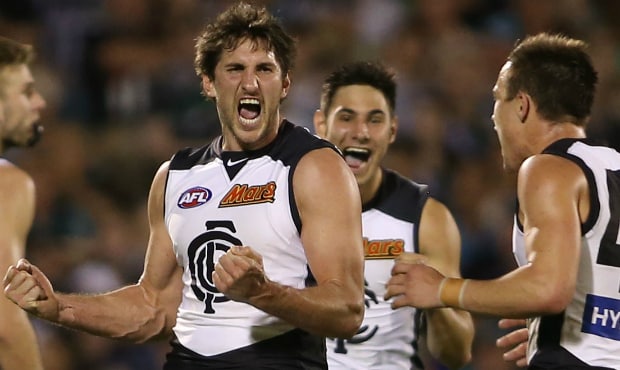
Collingwood
| Key stat | League rank | |
| Total disposals per game | 378.8 | 1st |
| Inside 50 differential | +8.0 | 2nd |
| Time in forward half differential | +5:41 | 2nd |
SUMMARY Collingwood uses short kicks and handballs to share the ball around. Its midfielders can gallop all game and know where to run to receive handballs. It is a shift from the long kicking game Nathan Buckley's predecessor favoured but it is one good teams employ. Collingwood's defensive structures are good so it is able to retain the ball in the back half, however opponents were too often in free space last year once they broke the defensive line. It meant opponents scored more easily than the Magpies when they went forward. – Peter Ryan
Essendon
| Key stat | League rank | |
| Average inside 50s per game | 54.9 | 1st |
| Total disposals per game | 375.9 | 2nd |
| Points per game from intercepts | 65.5 | 2nd |
SUMMARY Often maligned in previous years, Essendon's midfield has significantly improved and the addition of Brendon Goddard last year showed in the statistics. The Bombers got more of the ball and sent it inside 50 more last year than almost every team, through a more organised, disciplined approach. Often their approach to attack started in defence, though, and specifically with Cale Hooker, who was the club's leading intercept marker. – Callum Twomey
Fremantle
| Key stat | League rank | |
| Goals per inside 50 | 28.6% | 3rd |
| Uncontested marks per game | 89.9 | 1st |
| Opposition score per inside 50 | 44.5% | 2nd |
SUMMARY Each of these statistics is a consequence of Ross Lyon's philosophy of team pressure and team defence. Firstly, Fremantle is the third best side in the AFL for goals scored per inside 50 because of the ability to turn the ball over. The Dockers pressure opposition teams into turning the ball over and sharp ball movement and spread from the turnover means a high percentage of scores from entries because the opposition has not had time to set up its defence. The Dockers are number one for uncontested marks due to Lyon's want to take short options by foot. They are also the most miserly defence in the League and unsurprisingly rank in the top two for opposition scores per inside 50. The ability of the Dockers defenders to drop off their opponents and take intercept marks is a hallmark of their play. – Alex Malcolm
Matt de Boer led Fremantle in tackles in 2013. Picture: AFL Media
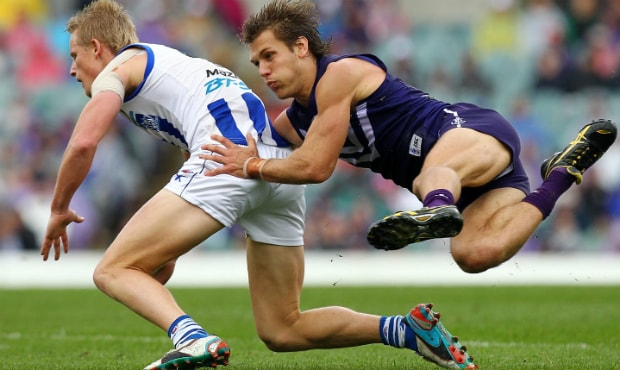
Geelong
| Key stat | League rank | |
| Inside 50s conceded per game | 46.5 | 2nd |
| Time in forward half differential | +10:29 | 1st |
| Opposition score from a clearance | 19.4% | 1st |
SUMMARY The Cats didn't finish the home and away season second on the ladder for no reason. They were very good at denying their opposition entries into attack, and they also generated a stack of inside 50s for themselves. They used an interesting strategy at clearances, often conceding the first possession to their opposition, then quickly winning the ball back by forcing that possession to miss its target. It was that strategy which enabled Chris Scott's team to concede the fewest scores from an opposition clearance in the competition. – Adam McNicol
Gold Coast
| Key stat | League rank | |
| Clearance winning % | 42.9% | Equal 1st |
| Opposition goal per inside 50 | 25.1% | 4th |
| Clearance leading to score % | 27.7% | 5th |
SUMMARY It's a mark of the Suns' brand and character they are ranked equal first in clearance win percentage for such a young list. Aside from sublime skipper Gary Ablett, they also have Dion Prestia and Jaeger O'Meara ranked inside the competition's top-40 in clearances by sheer volume. Throw in combative David Swallow and experienced bodies like Danny Stanley and Michael Rischitelli and you have a core of terrific ball hunters. It is little surprise then that they also rank fifth for turning clearances into scores. It should also be noted that while Zac Smith, Tom Nicholls or Charlie Dixon remain in the ruck, there's a fair chance Gold Coast will at least get an even-money crack at using the ball first. You can expect this to continue in 2014 with the likely additions of Jack Martin and Jesse Lonergan into the midfield rotation. – Michael Whiting
Greater Western Sydney
| Key stat | League rank | |
| Set shot accuracy | 66.5% | 3rd |
| Uncontested possession % | 62.1% | 5th |
| Tackles in defensive half per game | 35.2 | 4th |
SUMMARY The set shot statistic is encouraging for the Giants, led by young superstar Jeremy Cameron's stunning return of 62.27 in 2013. While their chances are often fleeting, it is a good sign they can show composure and capitalise on their opportunities. The fledgling side is also learning how to use space around the ground and enjoy uncontested possessions, a critical element for a team with so many young, undersized players. They do focus on contested possessions and punch above their weight, with the likes of Callan Ward, Tom Scully and Dylan Shiel happy to operate on the inside, but it's still no surprise they have a high uncontested possession rate at this stage of their development. So far the Giants have also spent much of their time at the defensive end, leading to a high number of tackles in their back half. But again, hardness and tackling are important features for the side and are helping to lay a platform for a talented team that should soon blossom into a competitive unit. – James Dampney
Tom Scully showed his willingness for the contested ball in 2013. Picture: AFL Media
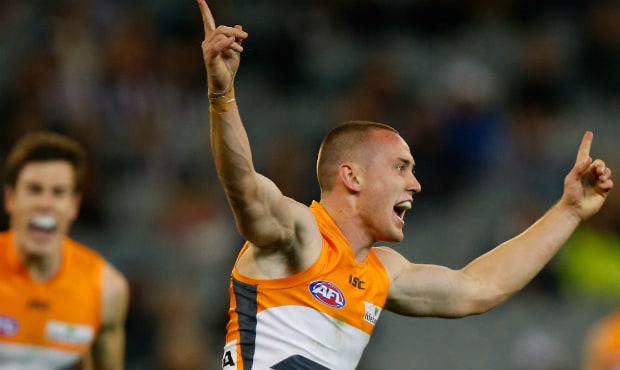
Hawthorn
| Key stat | League rank | |
| Goals per inside 50 | 30.4% | 1st |
| Disposal efficiency | 73.5% | 2nd |
| Tackles in defensive half per game | 35.2 | 4th |
SUMMARY These statistics paint a succinct summary of the Hawks as a team, and a blueprint for their premiership success: a potent, multi-faceted forward line, pinpoint disposal by hand and foot – particularly from the back half – and ruthless forward pressure led by tackling machines Luke Breust, Cyril Rioli and Paul Puopolo. – Mark Macgugan
Melbourne
| Key stat | League rank | |
| Scores from kick-in per game | +1.0 | Equal 5th |
| Set shot accuracy | 63.2 % | 8th |
| Opposition effective long kicks per game | 54.9 | 6th |
SUMMARY It's no secret the Demons have the ball entering inside their defensive 50 a lot, so they have had to adapt and turn a negative in to a positive. As such, the Demons have worked out an effective way for transitioning the ball from defence to attack. Melbourne's fast ball movement became a key part of the club's scoring chains, allowing the forwards to take their set shots from reasonable spots. Their competition rank of eighth for set shot accuracy is testament to that. Expect the scores from kick-ins to change marginally next season, as the Demons will find better ways to win the ball out of the middle under Paul Roos. As will the team's capacity to deny the opposition easy passage toward their goals. That will form part of Roos' mantra, as he seeks to improve every aspect of the Demons' side. – Ben Guthrie
North Melbourne
| Key stat | League rank | |
| Goals per inside 50 | 30.3% | 2nd |
| Disposal efficiency | 74.3% | 1st |
| Clearance differential | +5.9 | 1st |
SUMMARY With clearance machines such as Andrew Swallow, Jack Ziebell and Ben Cunnington, it was no surprise North dominated at stoppages in 2013. It might surprise some, however, that the Roos' disposal efficiency was the best in the competition. In recent years, the Roos have widely been seen as a blue-collar team short on polish. But that perception now appears outdated, with star recruit Nick Dal Santo set to add even more class to North's ball use in 2014. The Roos' elite ability to create goals out of inside 50 entries reflects both their good delivery and the potency of an attack headed by Drew Petrie, Lindsay Thomas and the emerging Aaron Black. – Nick Bowen
Port Adelaide
| Key stat | League rank | |
| Tackles per game | 67.1 | 3rd |
| Time in forward half differential | +4:49 | 4th |
| Clearance leading to score % | 29.2% | 2nd |
SUMMARY The Power have built a side that thrives on tackling and Ken Hinkley's defensive game plan only adds to it. The likes of Brad Ebert, Kane Cornes, Ollie Wines and skipper Travis Boak are all tackle machines – as is ruckman Matthew Lobbe. Tackles at stoppages can often lead to clearances and when the Power clear the ball to their forward line they have the firepower to make the most of the opportunity. Forwards like Jay Schulz, Chad Wingard, Angus Monfries and Robbie Gray only need half a chance to score – but their midfielders are also equally adapt at finishing the job once the ball is cleared. – Harry Thring
Richmond
| Key stat | League rank | |
| Contested possession differential | +8.4 | 2nd |
| Score per inside 50 | 52.0% | 4th |
| Disposal efficiency | 73.4% | 3rd |
SUMMARY The Tigers used Jack Riewoldt further up the ground in 2013 in an effort to find a greater spread of goalkickers. While some criticised the move, it resulted in a less predictable forward line and gave the team more attacking options, which explains the scores per inside 50 ranking. The Tigers' clean foot skills were also instrumental in getting the ball to their forwards in good positions, allowing them to convert consistently. While he led the team with 58 goals, Riewoldt played a key role in setting up his teammates, ranking No.1 for his club for goal assists (he ranked No.3 in the competition in this category). Richmond played a slick brand of football in 2013, keeping stoppage numbers low and doing its best work on the outside. This generally resulted in less contested play, less tackling and a higher disposal efficiency. When the ball was up for grabs, however, the Tigers didn't flinch, with coach Damien Hardwick instilling on a hard edge in his players. – Nathan Schmook
Richmond will be hoping a greater array of goalkickers will bring more of this in 2014. Picture: AFL Media
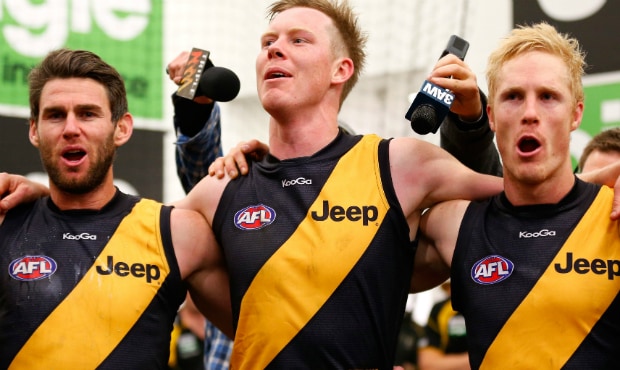
St Kilda
| Key stat | League rank | |
| Disposal efficiency | 73.1% | 4th |
| Uncontested possession rate | 63.7% | 1st |
| Offensive one-on-one winning % | 30.7% | 3rd |
SUMMARY The Saints played an open style of game under Scott Watters after breaking away from the ultra-defensive model of Ross Lyon. While this style was an attempt to inject more scoring, it often left them vulnerable on the counter-attack. It's no surprise they were the team with the most uncontested possessions in the competition given the way they played, which also saw them give away plenty of uncontested marks to the opposition but have the space to hit targets - reflected in their disposal efficiency that ranked them fourth overall. While they ranked highly in both these areas, that's not necessarily a good thing and there's a strong possibility we'll see a change under Alan Richardson, who will need to find a balance between the styles of Lyon and Watters. – Jennifer Phelan
Sydney Swans
| Key stat | League rank | |
| Tackles per game | 71.7 | 1st |
| Points from clearance differential | +14.5 | 2nd |
| Points against per game | 77.0 | 2nd |
SUMMARY It is no great shock to see the Swans once again top the tackling count. That side of the game has been their bread and butter for years and they continue to be the competition's yardstick. It is a source of pride and it is merely assumed that every player that enters the club will focus on becoming an elite tackler. The Swans were also an incredibly efficient team around the stoppages in 2013. With Mike Pyke and former ruckman Shane Mumford often giving them first-use of the ball, and Josh Kennedy comfortably laying claim to being the AFL's best clearance player, the Swans are able to secure possession and quickly get it into their forward line and score. Coupled with their tackling intensity is the team's overall defence. They are regularly among the competition's most miserly sides and play a clamping, accountable brand of football that ensures their opposition are rarely allowed to score heavily. – James Dampney
West Coast
| Key stat | League rank | |
| Score per inside 50 | 53.2% | 1st |
| Hit out to advantage differential | +5.2 | 1st |
| Tackles per game | 68.7 | 2nd |
SUMMARY The three stats point to the Eagles key strengths in 2013. They are first for scores per inside 50 because of their directness under John Worsfold. The former coach preferred one-on-one football and loathed to allow teams to drop a loose defender back. They also had two towering targets in Josh Kennedy and Jack Darling who kicked 102 goals between them. The Eagles tackling is also a reflection of Worsfold's influence. Players like Scott Selwood, Matt Priddis and Mark Hutchings embody their former coach's philosophy of a ferocious attack on the ball carrier. – Alex Malcolm
Western Bulldogs
| Key stat | League rank | |
| Contested possession differential | +12.5 | 1st |
| Disposal differential | +20.5 | 5th |
| Clearance differential | +5.2 | 2nd |
SUMMARY The Western Bulldogs had no trouble getting their hands on the ball in 2013, and that's mainly due to the uncompromising approach of its tough midfielders, particularly Matthew Boyd and Tom Liberatore. Contested ball is their go, and Will Minson spoon-fed his teammates with a blistering year in the ruck. This was a source of pride for the club, even during the tough times last season. The Dogs have plenty of players hoping to get a run through the middle next season, and there has been a heavy focus on stoppages at training this summer. – Jacqui Reed
Matthew Boyd and Tom Liberatore embrace after upsetting the Eagles in round 18. Picture: AFL Media
